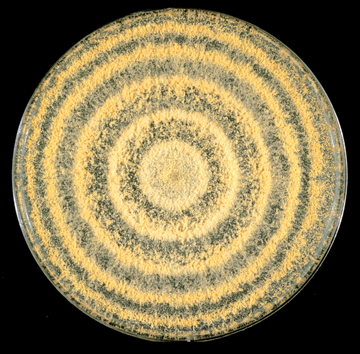This laboratory studies the biological clocks that drive circadian (daily) rhythms in bacteria, plants, fungi and animals. Because these rhythms are found in all domains of life and at all levels of organization from single cells to whole animals, they are a fundamental property of living things.

This is a 15 cm Petri plate with agar growth medium, inoculated in the middle with Neurospora. As the fungal colony expanded, it made bands of yellow spores every day alternating with thinner growth.
We study genes that affect the clock. Previous research has shown that there are common features to the clocks in all organisms: a set of genes produce proteins that interact to turn each other's expression on and off in a 24-hour feedback loop. These clock-related genes are different in every organism. Does this mean that there are different clocks in every organism, or could there be one universal clock?
Although these feedback loops are clearly important in clock mechanisms, rhythms can still be seen when these feedback loops are not functioning. We are trying to find out what other genes are involved in making an organism rhythmic when the feedback loops are not functioning.
We are using the fungus Neurospora crassa as a model organism to study these clocks, because it is easy to grow and work with in the lab, it has been studied for many years, and its rhythm of spore-formation is easy to see. We are interested in genes that are important for maintaining rhythms outside of the known feedback loops. We have found two genes that are important for the clock in the fungus, and it turns out that these genes are found in all organisms, but no one knew they were clock-related. This might mean that we have two clues about the identity of a possible universal clock. We are studying these genes to find out what products they make and how those products function, and how they might interact with the proteins of the well-known feedback loop.
We expect that this research will tell us more about how daily clocks are constructed, and how living things can tell time. The information will be useful to anyone studying cells and how they organize their internal processes, and anyone studying whole organisms and how they interact with the daily cycles in their environment.
